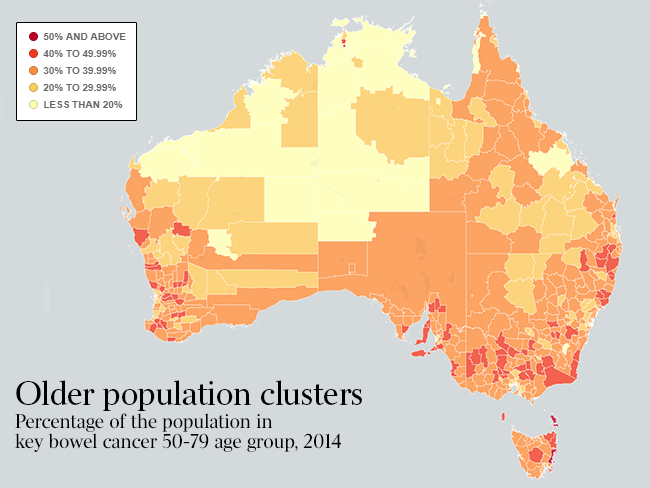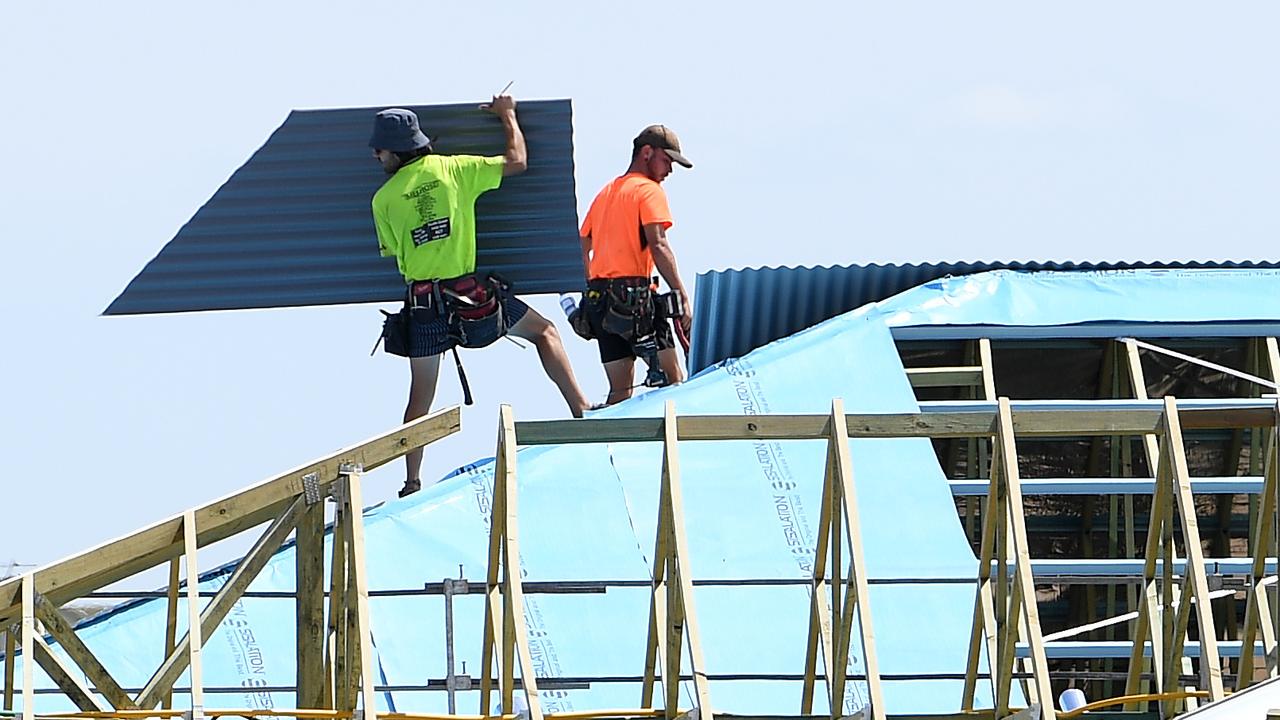Where the sourge of bowel cancer is worst in Australia
I think I have become an unofficial ambassador for Bowel Cancer Australia.
I think I have become an unofficial ambassador for Bowel Cancer Australia. Not because I have contracted and survived bowel cancer, but because I became interested in the subject a decade ago. It was at this time that my then 47-year-old sister died of bowel cancer, leaving a grieving husband and nine children aged 7-27.
Every death and especially every young death is a tragedy but even more so when it is preventable through early detection. This is the story of the demographics of bowel cancer.
In some ways this disease can be regarded as the miner’s canary of the ageing population. It particularly effects people after the age of 50, putting the baby boomers in the firing line over the next decade.
Most deaths in Australia are related to conditions of the heart or to various forms of cancer. As the population ages more and more deaths are expected to be associated with older afflictions such as Alzheimer’s and dementia. One of the malignancies claiming the lives of more than 4000 Australians every year is bowel cancer.

The tragedy is that it is largely preventable. There are around 15,000 incidences of bowel cancer reported each year with more than two-thirds of patients making a full recovery.
Unlike cancers that attack vital organs cancer of bowel can be surgically removed; the human body can operate without the entire bowel. Surgical removal of cancer is far less successful with cancers that attack the vital organs.
More than half the bowel cancer deaths in 2013 applied to the 29 per cent of the population aged 50-79. Bowel cancer afflicts the middle aged with progressive lethality. At the age of 55 bowel cancer kills 11 Australians per 100,000 in this age group; by 79 this rate leaps tenfold to 104 deaths per 100,000.
The nation is moving rapidly into the key at-risk age group. In 2016, seven million occupy what might be termed the bowel-cancer stage of the life cycle. Just over a decade ago five million Australians straddled the 50-79 age group. By 2026 this at-risk bowel-cancer cohort is projected to contain more than eight million Australians including the entire baby boomer generation plus a smattering of younger generation Xers.
Education and early detection programs are strategies that should apply across the entire population. But in a world of limited resources it is important to understand where the incidence is highest.
Whereas 22 per cent of the national population is aged 50-79 there are municipalities where this rate exceeds 40 per cent. These older enclaves offer a critical mass of potential targets for bowel cancer and therefore should also be targets for education programs, cancer treatment infrastructure and medical services.
There are 10 local government areas (with a critical mass of population) where more than 40 per cent of the population sits within the 50-79 age group and where bowel cancer is likely to be most lethal. These include the rural and/or retirement communities of Victor Harbor, Mid Murray and Yorke Peninsula in South Australia; Great Lakes, Eurobodalla and Gloucester in NSW, Break O’Day in Tasmania; and Pyrenees and Loddon in Victoria.
My team has accessed bowel cancer deaths by place of residence of the deceased in 2012 which is the latest year for which data at the small area level is available. The number of bowel cancer deaths by local government area has been converted into a rate of deaths per 100,000 local residents.
The data source includes deaths up to the age of 74; deaths over this age are considered to be less preventable. There is a direct correlation between critical mass of the over-50 population and bowel cancer deaths.
The death rate from bowel cancer in the 0-74 age group in 2012 exceeded 20 per 100,000 in places where there is a high proportion of the population aged 50-79 namely the Shire of Gingin in WA; the shires of Murrindindi, Buloke and Pyrenees in Victoria and the shires of Bland, Gloucester, Goulburn-Mulwaree and Upper Lachlan in NSW.
The death rate among the 0-74 age group from bowel cancer is generally lower in capital cities but in some places this figure exceeds 15 per 100,000 in communities such as the Shire of Murray in Perth and the City of Glenorchy and the Municipality of Kingborough in Hobart. In Melbourne the peak death rate from bowel cancer is in the City of Whitehorse (12 per 100,000), in Sydney it is Wyong (also 12 per 100,000), in Adelaide it is Walkerville (14 per 100,000) and in Brisbane it is Somerset (11 per 100,000).
This is not to suggest that resources have not been directed at bowel cancer. A recent study into the delivery of colonoscopy services shows that MBS utilisation rates have lifted from 222,000 in the year to June 2005 to 335,000 a decade later. This is a 50 per cent increase but more can be expected given the direct link between bowel cancer and the number of people in the population aged 50-and-over.
There are 26 cancer treatment centres scattered throughout Australia and which are designed to address many forms of cancer including bowel cancer. Over time these centres have been positioned to service the majority of at-risk regional populations. But there are some parts of the country that are well removed from convenient access to cancer treatment centres.
Access to treatment centres is poorest from the Victorian Wimmera and Mallee, from the mid-north coast of WA, from the Mackay region of Queensland, and from the central west of NSW servicing the region around Dubbo. The north west of Tasmania is also beyond convenient reach of the cancer centre in Hobart.
The low-hanging fruit of early detection is awareness in the older enclaves of rural and regional Australia. Yes there are more bowel cancer deaths in our capital cities but the death rate is much higher in rural communities. A national awareness program is needed. The baby boomer generation is pushing squarely into the sightlines of the bowel cancer affliction. Over the coming decade close to two million additional boomers and older generation Xers will be subjected to the bowel cancer lottery.
An ageing population is in many ways a wonderful dividend of a prosperous and well managed society. Nevertheless we cannot ignore the challenges that ageing presents including issues around the rise of dementia, Alzheimer’s and the delivery of aged care services.
I somehow think that our greatest challenges will come in the early years of our nation’s ageing, from the escalating and deadly afflictions that attack the post-50 cohort when so many are in fact still with us.
Bernard Salt is a KPMG Partner and an adjunct professor at Curtin University Business School; based on Bowel Cancer research report by KPMG Demographics April 2016; research by Nicole Bates; bsalt@kpmg.com.au; bernardsalt.com.au




To join the conversation, please log in. Don't have an account? Register
Join the conversation, you are commenting as Logout